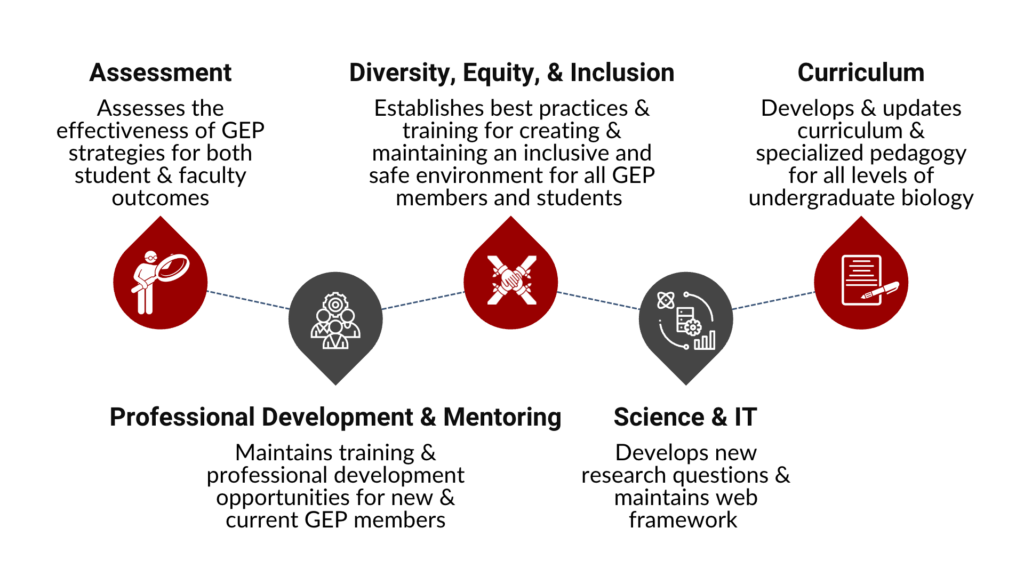History
Founded in 2006
In June 2005, Dr. Sarah “Sally” C.R. Elgin held a one-day hands-on introductory workshop at Washington University in St. Louis, to show visiting faculty what her students were able to do in genome annotation. The 17 faculty who attended all signed on to a proposal to the Howard Hughes Medical Institute (HHMI) to establish the Genomics Education Partnership (GEP). The HHMI grant was funded, and GEP’s first cohort of members attended a full training workshop in June 2006. GEP’s founding was motivated by the need to bring genomics and bioinformatics into the undergraduate curriculum, and the desire to do so while engaging students in research. There is a need for substantial human cognitive effort to improve assemblies and annotate genomes in order to answer interesting questions about the role of genome structure in maintaining genome stability and regulating gene expression.
The GEP was created with these core goals:
- Introducing bioinformatics in general and genomics in particular into the undergraduate curriculum, while providing students with a research experience;
- Establishing an inclusive and open partnership at a scale that can tackle big (megabase) projects requiring many student investigators working in parallel;
- Modeling “team science” that requires substantive contributions of the lead investigator, the participating faculty, and the students, as well as expertise from colleagues in computer science and in genome sequencing, in a mutually supportive and beneficial collaboration;
- Publishing results in the scientific literature with all participating faculty and students contributing as co-authors on the final publication;
- Regularly publishing assessment results in the educational literature to contribute to the scholarship of teaching and learning.
Under Dr. Elgin’s leadership from 2006 to 2017, the GEP grew to a vibrant, collaborative, and productive group of more than 100 highly dedicated faculty and exposed thousands of students to genomics research.
Transition to GEP 2.0
To maintain our core mission, achieve sustainability beyond Dr. Elgin’s retirement (or the departure of any particular member), and expand our ability to address current and future needs in STEM education, the GEP began transitioning to a more sustainable, robust, decentralized, and cost-effective model in 2018, colloquially referred to as “GEP 2.0.”
The leadership structure of GEP 2.0 is distributed across five specialized committees—Assessment, Curriculum, Diversity, Equity, & Inclusion (DEI), Professional Development & Mentoring (PDM), and Science & IT—each of which addresses specific priorities and are overseen by the Steering Committee.

The GEP is currently supported by two five-year grants— a $2.2 million award from the National Institutes of Health (NIH; Project No. R25GM130517) and a $1.99 million grant from the National Science Foundation (NSF; Award No. 1915544).
In April 2019, the GEP was awarded funding by the NIH’s Innovative Programs to Enhance Research Training (IPERT) to sustain and develop centralized support and regional training. A main focus of the IPERT grant is to increase faculty and student engagement in the GEP by leveraging the available regional clusters of participating GEP institutions (Regional Nodes). Each of the 13 Regional Nodes will offer several Regional Symposia and at least one training workshop. The Regional Symposia serve the dual functions of allowing undergraduates to present their work to other scientists, and faculty to learn, collaborate, mentor, and develop curricula. The Node training workshops expand the timing and location options for GEP training, thereby increasing and diversifying participation while testing a new regional training format. A particular goal of these Regional Node activities is the recruitment and support of new members from Community Colleges and Minority-Serving Institutions.
In October 2019, the GEP was awarded funding by the NSF’s Improving Undergraduate STEM Education (IUSE) to provide training and mentoring to faculty who are geographically isolated or have impediments to participating in scheduled face-to-face trainings. A main focus of the IUSE grant is to develop an online training, mentoring, and support system for new GEP faculty and also to diversify the scientific questions GEP can address. Broadening the scientific scope of GEP by increasing the number of scientific projects will motivate and recruit GEP faculty, boost students’ intellectual engagement, and expand GEP’s research impact.
The paired approaches of the IPERT and IUSE grants give GEP broader outreach and a unique opportunity to determine if a seemingly more economical online training strategy is actually sufficient to support implementation and persistence in the GEP.
